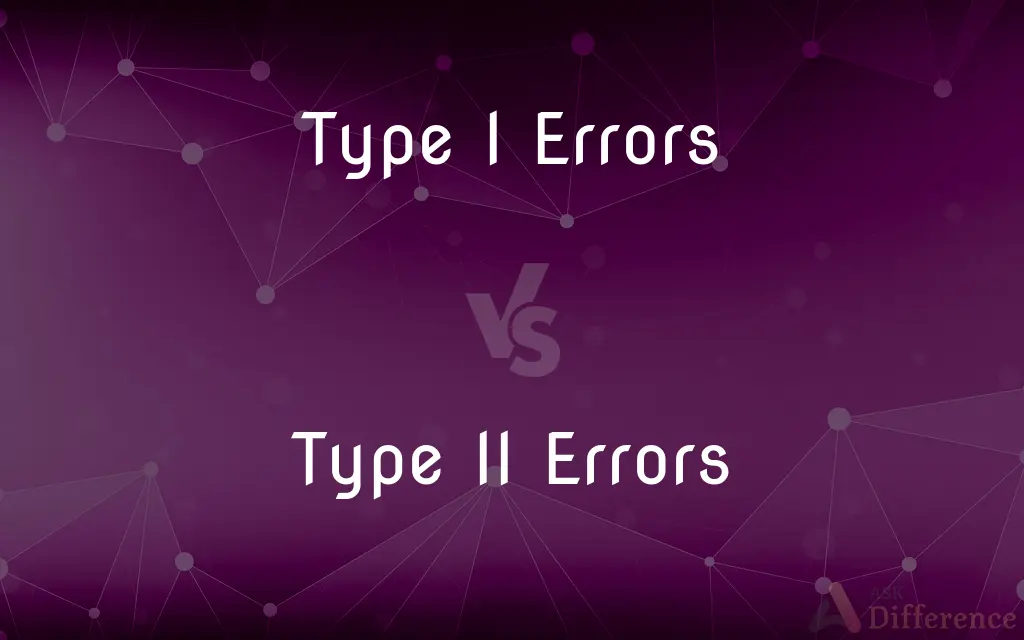Type I Errors vs. Type II Errors — What's the Difference?
By Tayyaba Rehman — Published on December 22, 2023
Type I Errors occur when a true null hypothesis is rejected, while Type II Errors happen when a false null hypothesis is accepted.

Difference Between Type I Errors and Type II Errors
Table of Contents
ADVERTISEMENT
Key Differences
Type I Errors and Type II Errors are terms predominantly used in the realm of hypothesis testing in statistics. Type I Errors, often symbolized by the Greek letter alpha (α), represent scenarios where the null hypothesis is true, but the data causes it to be erroneously rejected. Essentially, it's a "false positive," suggesting an effect or association when none exists. In medical testing, for example, this would equate to diagnosing a healthy person as sick.
On the other side, we have Type II Errors, denoted by beta (β). These occur when the null hypothesis is false, yet the data leads to it being wrongly accepted. In simpler terms, it's a "false negative." Using the same medical testing analogy, this would be akin to failing to detect a disease in someone who is actually sick. It suggests no effect or association exists when, in reality, one does.
While both Type I Errors and Type II Errors are undesirable, they have different implications. The consequences of committing a Type I Error can be significant, especially if decisions are based on false positives. For instance, investing in a new drug that isn't effective can waste resources. Conversely, the repercussions of Type II Errors can be just as grave. If a genuinely beneficial treatment isn't recognized due to such an error, opportunities for better outcomes might be missed.
It's essential to grasp the distinction between Type I Errors and Type II Errors, as they play crucial roles in determining the validity of scientific results. Researchers typically set thresholds for these errors to manage and balance their occurrence. Deciding the acceptable rates for these errors depends on the study's context and potential consequences of each error type.
Comparison Chart
Definition
Rejection of a true null hypothesis
Acceptance of a false null hypothesis
ADVERTISEMENT
Common Term
False positive
False negative
Symbol
α (alpha)
β (beta)
Consequence Example
Diagnosing a healthy person as sick
Failing to diagnose a sick person
Impact on Research
Might suggest a nonexistent effect
Might overlook a genuine effect
Compare with Definitions
Type I Errors
Type I Errors involve mistakenly rejecting a true null hypothesis.
The detection of a drug's effect, when it has none, can result from Type I Errors.
Type II Errors
Type II Errors happen due to insufficient evidence against the null hypothesis.
Small sample sizes often increase the risk of Type II Errors in research.
Type I Errors
Type I Errors occur when data falsely suggests an effect.
Detecting a difference between two identical products can be due to Type I Errors.
Type II Errors
Type II Errors can prevent recognizing genuine effects.
Not noticing an improvement in plant growth with a new fertilizer might be a Type II Error.
Type I Errors
The significance level, often denoted α, represents the probability of Type I Errors.
Setting a 5% significance level means we accept a 5% chance of making Type I Errors.
Type II Errors
Type II Errors occur when a false null hypothesis is wrongly accepted.
Overlooking the effectiveness of a beneficial medication can be attributed to Type II Errors.
Type I Errors
Type I Errors arise from random variations in data.
Even with precise measurements, Type I Errors can cause incorrect rejection of a valid hypothesis.
Type II Errors
They are the "false negatives" in hypothesis testing.
Failing to detect contaminants in clean water samples is similar to committing Type II Errors.
Type I Errors
Type I Errors are considered false positives in hypothesis testing.
A weather forecast predicting rain, when it remains sunny, is analogous to Type I Errors.
Type II Errors
The power of a test (1 - β) indicates its ability to avoid Type II Errors.
A test with 80% power has a 20% chance of making Type II Errors.
Common Curiosities
Are Type I Errors linked to the significance level of a test?
Yes, the significance level (α) represents the probability of making Type I Errors.
Which is more severe, Type I or Type II Errors?
The severity depends on context; both can have significant implications depending on the situation.
How can one reduce the chances of Type II Errors?
Increasing the sample size or improving measurement precision can reduce Type II Errors.
What symbols are commonly used for Type I and Type II Errors?
Type I Errors are represented by α (alpha) and Type II by β (beta).
What are Type I Errors in hypothesis testing?
Type I Errors occur when a true null hypothesis is incorrectly rejected, leading to false positives.
How do Type II Errors influence decision-making?
They might prevent recognizing genuine effects, leading to missed opportunities.
How do Type II Errors differ from Type I Errors?
Type II Errors arise when a false null hypothesis is wrongly accepted, resulting in false negatives.
How do Type I Errors affect scientific research?
They can suggest effects that don't exist, potentially leading to false conclusions.
How do power and Type II Errors relate?
The power of a test (1 - β) indicates its ability to avoid Type II Errors.
Can setting a stricter significance level reduce Type I Errors?
Yes, but it might increase the risk of Type II Errors.
Can a test be completely free of both Type I and Type II Errors?
Practically, no. Reducing one type often increases the chance of the other.
Why is it essential to balance Type I and Type II Errors?
It ensures the validity of results while considering the implications of incorrect decisions.
Can both Type I and Type II Errors occur in the same study?
Yes, both errors relate to different aspects and can occur based on different hypotheses or conditions.
Are these errors exclusive to statistics?
Predominantly, but the concepts can be applied in various fields involving decision-making.
How can researchers manage these errors?
By setting appropriate significance levels, ensuring adequate sample sizes, and using accurate measurement tools.
Share Your Discovery

Previous Comparison
Allusive vs. Illusive
Next Comparison
ANSI vs. UTF-8Author Spotlight
Written by
Tayyaba RehmanTayyaba Rehman is a distinguished writer, currently serving as a primary contributor to askdifference.com. As a researcher in semantics and etymology, Tayyaba's passion for the complexity of languages and their distinctions has found a perfect home on the platform. Tayyaba delves into the intricacies of language, distinguishing between commonly confused words and phrases, thereby providing clarity for readers worldwide.












































